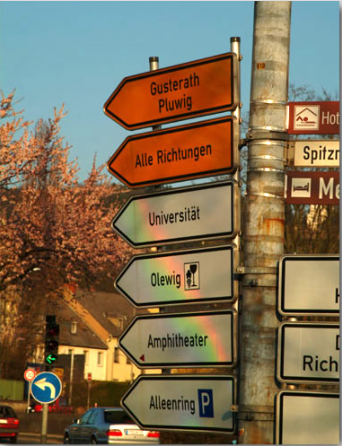Traffic sign rainbows
Traffic Sign Rainbows: A Delightful Optical Phenomenon
Have you ever noticed rainbows appearing on traffic signs? It's a fascinating optical phenomenon that occurs due to the presence of glass beads on their surfaces. While we are familiar with rainbows forming in the sky after rainfall, these miniature versions on traffic signs offer a unique and captivating sight. In this article, we will delve into the science behind these traffic sign rainbows, exploring why they occur and what makes them different from natural rainbows.
When light interacts with the glass beads incorporated into traffic signs, it undergoes a process of refraction and reflection, similar to what happens when light passes through raindrops. The glass beads have a high refractive index, causing the light to bend as it enters and exits the beads. This bending of light creates a beautiful display of colors, just like a traditional rainbow.
However, there is a significant difference between traffic sign rainbows and their natural counterparts. Glass bead bows are much smaller in size compared to rainbows in the sky. This discrepancy arises because glass has a stronger refractive ability than water droplets found in the atmosphere. As a result, the bending of light is more pronounced in glass beads, leading to a more compact and concentrated rainbow-like pattern.
To witness these enchanting traffic sign rainbows, you can look for signs that have a retroreflective coating containing glass beads. These coatings are commonly used to enhance visibility during nighttime or low-light conditions. When light from car headlights or other sources hits these coated signs at the right angle, the glass beads come into play, producing mesmerizing rainbow hues.
The appearance of traffic sign rainbows can vary depending on several factors, such as the angle of incoming light, the size and distribution of the glass beads, and the condition of the sign's surface. In some cases, you may observe a complete circular rainbow surrounding the sign, while in others, only a partial arc may be visible. The colors displayed can range from vibrant reds and oranges to soothing blues and purples, adding a touch of whimsy to the urban landscape.
It's worth noting that the phenomenon of traffic sign rainbows is not limited to just one location. People have reported sightings of these miniature rainbows on signs across different countries and continents. Whether you're in Germany, the United States, or any other part of the world, keep an eye out for these delightful optical surprises during your daily commute.
The study of atmospheric optics encompasses a wide range of optical phenomena, including rainbows, halos, and sundogs. These natural wonders continue to inspire scientists and enthusiasts alike, sparking curiosity about the mysteries of light and its interaction with the atmosphere. By observing and understanding phenomena like traffic sign rainbows, we gain a deeper appreciation for the beauty and complexity of the world around us.
In conclusion, traffic sign rainbows are a captivating sight that arises from the presence of glass beads on their surfaces. These miniature rainbows result from the refraction and reflection of light within the glass beads, producing vibrant colors reminiscent of their natural counterparts. While smaller in size, these enchanting optical displays add a touch of wonder to our urban environments. So, next time you're on the road, take a moment to appreciate these delightful traffic sign rainbows and marvel at the magic of light.

Signs sometimes show rainbows. The glass beads incorporated into their surfaces refract and reflect light like raindrops.
There is a difference, glass bead bows are much smaller because glass refracts light more strongly.
Imaged by Eva Seidenfaden (atmospheric optics and astronomy site) at Trier, Germany.
©Eva Seidenfaden, shown with permission.
Note: this article has been automatically converted from the old site and may not appear as intended. You can find the original article here.
Reference Atmospheric Optics
If you use any of the definitions, information, or data presented on Atmospheric Optics, please copy the link or reference below to properly credit us as the reference source. Thank you!
-
<a href="https://atoptics.co.uk/blog/traffic-sign-rainbows/">Traffic sign rainbows</a>
-
"Traffic sign rainbows". Atmospheric Optics. Accessed on November 26, 2024. https://atoptics.co.uk/blog/traffic-sign-rainbows/.
-
"Traffic sign rainbows". Atmospheric Optics, https://atoptics.co.uk/blog/traffic-sign-rainbows/. Accessed 26 November, 2024
-
Traffic sign rainbows. Atmospheric Optics. Retrieved from https://atoptics.co.uk/blog/traffic-sign-rainbows/.